
PS/EARTH SCIENCE
The University of the State of New York
REGENTS HIGH SCHOOL EXAMINATION
PHYSICAL SETTING
EARTH SCIENCE
Wednesday, June 22, 2005 — 9:15 a.m. to 12:15 p.m., only
This is a test of your knowledge of Earth science. Use that knowledge to answer
all questions in this examination. Some questions may require the use of the Earth
Science Reference Tables. The Earth Science Reference Tables are supplied separately.
Be certain you have a copy of the 2001 edition of these reference tables before you
begin the examination.
Your answer sheet for Part A and Part B–1 is the last page of this examination
booklet. Turn to the last page and fold it along the perforations. Then, slowly and
carefully, tear off your answer sheet and fill in the heading.
The answers to the questions in Part B–2 and Part C are to be written in your
separate answer booklet. Be sure to fill in the heading on the front of your answer
booklet.
You are to answer all questions in all parts of this examination according to the
directions provided in the examination booklet. Record your answers to the Part A
and Part B–1 multiple-choice questions on your separate answer sheet. Write your
answers to the Part B–2 and Part C questions in your answer booklet. All work should
be written in pen, except for graphs and drawings, which should be done in pencil.
You may use scrap paper to work out the answers to the questions, but be sure to
record all your answers on your separate answer sheet and in your answer booklet.
When you have completed the examination, you must sign the statement printed
at the end of your separate answer sheet, indicating that you had no unlawful
knowledge of the questions or answers prior to the examination and that you have
neither given nor received assistance in answering any of the questions during the
examination. Your answer sheet and answer booklet cannot be accepted if you fail to
sign this declaration.
Notice. . .
A four-function or scientific calculator and a copy of the 2001 Earth Science Reference Tables
must be available for you to use while taking this examination.
The use of any communications device is strictly prohibited when taking this
examination. If you use any communications device, no matter how briefly, your
examination will be invalidated and no score will be calculated for you.
DO NOT OPEN THIS EXAMINATION BOOKLET UNTIL THE SIGNAL IS GIVEN.
E C N E I C S H T R A E / S P

Part A
Answer all questions in this part.
Directions (1–35): For each statement or question, write on your separate answer sheet the number of the
word or expression that, of those given, best completes the statement or answers the question. Some questions
may require the use of the Earth Science Reference Tables .
1 Which list of three planets and Earth’s Moon is
6 The diagram below represents the elliptical orbit
arranged in order of increasing equatorial dia-
of a moon revolving around a planet. The foci of
meter?
this orbit are the points labeled F 1 and F 2 .
(1) Earth’s Moon, Pluto, Mars, Mercury
(2) Pluto, Earth’s Moon, Mercury, Mars
(3) Mercury, Mars, Earth’s Moon, Pluto
Moon
(4) Mars, Mercury, Pluto, Earth’s Moon
2 If Earth’s axis were tilted 35° instead of 23.5°, the
Planet
average temperatures in New York State would
F 1
F 2
most likely
(1) decrease in both summer and winter
(2) decrease in summer and increase in winter
(3) increase in summer and decrease in winter
(4) increase in both summer and winter
(Drawn to scale)
3 Which star has a higher luminosity and a lower
temperature than the Sun?
What is the approximate eccentricity of this
elliptical orbit?
(1) Rigel
(3) Alpha Centauri
(2) Barnard’s Star
(4) Aldebaran
(1) 0.3
(3) 0.7
(2) 0.5
(4) 1.4
4 Starlight from distant galaxies provides evidence
7 The coldest climates on Earth are located at or
that the universe is expanding because this
near the poles primarily because Earth’s polar
starlight shows a shift in wavelength toward the
regions
(1) red-light end of the visible spectrum
(1) receive mostly low-angle insolation
(2) blue-light end of the visible spectrum
(2) receive less total yearly hours of daylight
(3) ultraviolet-ray end of the electromagnetic
(3) absorb the greatest amount of insolation
spectrum
(4) are usually farthest from the Sun
(4) gamma-ray end of the electromagnetic spec-
trum
8 Compared to an inland location, a location on an
ocean shore at the same elevation and latitude is
5 On which day of the year would the intensity of
likely to have
insolation at Kingston, New York, most likely be
(1) cooler winters and cooler summers
greatest?
(2) cooler winters and warmer summers
(1) March 21
(3) September 23
(3) warmer winters and cooler summers
(2) June 21
(4) December 21
(4) warmer winters and warmer summers
P.S./E. Sci.–June ’05
[2]

9 The diagram below represents a Foucault pendu-
11 The diagram below represents the Moon in its
lum swinging freely for 8 hours.
orbit, as viewed from above Earth’s North Pole.
Position 1 represents a specific location of the
Moon in its orbit.
Swing
ong
Key
Lighted part
Dark part
ee
of Moon
of Moon
200
We
0
Position 1
Steel
2
4
ball
6
8 hours
Floor
Sun’s
North
Pole
rays
The Foucault pendulum appears to gradually
Earth
change its direction of swing due to Earth’s
(1) orbit around the Sun (3) tilted axis
(2) curved surface
(4) spin on its axis
Moon’s orbit
(Not drawn to scale)
10 The diagram below shows the noontime shadows
cast by a student and a tree.
Which phase of the Moon will be seen from
Earth when the Moon is at position 1?
( 1 )
( 2 )
( 3 )
( 4 )
If the time is solar noon and the student is located
12 During nighttime cooling, most of the energy
in New York State, in what direction is the stu-
radiated by Earth’s oceans into space is
dent facing?
(1) ultraviolet rays
(3) visible light rays
(1) north
(3) east
(2) gamma rays
(4) infrared rays
(2) south
(4) west
13 Landscapes with horizontal bedrock structure,
steep slopes, and high elevations are classified as
(1) plateau regions
(3) lowland regions
(2) plain regions
(4) mountain regions
P.S./E. Sci.–June ’05
[3]
[OVER]

14 Which map view best represents the pattern of
17 Which surface soil conditions allow the most infil-
isobar values, in millibars, and the pattern of wind
tration of rainwater?
flow, shown by arrows, at Earth’s surface sur-
(1) steep slope and permeable soil
rounding a Northern Hemisphere low-pressure
(2) steep slope and impermeable soil
center?
(3) gentle slope and permeable soil
(4) gentle slope and impermeable soil
18 The map below shows a river emptying into an
L
L
ocean, producing a delta.
9 92
9 92
9 96
9 96
Ocean
1 0 0 0
1 0 0 0
Land
( 1 )
( 3 )
a
t
D
R
i v e
r
L
L
1 0 0 0
1 0 0 0
Land
9 96
9 96
9 9 2
9 9 2
Which graph best represents the relationship
( 2 )
( 4 )
between the distance from the river delta into the
ocean and the average size of sediments deposited
15 An observer measured the air temperature and
on the ocean floor?
the dewpoint and found the difference between
them to be 12°C. One hour later, the difference
between the air temperature and the dewpoint
was found to be 4°C. Which statement best
describes the changes that were occurring?
(1) The relative humidity was decreasing and the
chance of precipitation was decreasing.
(2) The relative humidity was decreasing and the
Distance from Delta
Distance from Delta
chance of precipitation was increasing.
Into the Ocean
Into the Ocean
(3) The relative humidity was increasing and the
( 1 )
( 3 )
chance of precipitation was decreasing.
(4) The relative humidity was increasing and the
chance of precipitation was increasing.
16 Which two ocean currents are both warm cur-
rents that primarily flow away from the equator?
(1) Guinea Current and Labrador Current
(2) Brazil Current and Agulhas Current
Distance from Delta
Distance from Delta
(3) Alaska Current and Falkland Current
Into the Ocean
Into the Ocean
(4) Canaries Current and Gulf Stream Current
( 2 )
( 4 )
P.S./E. Sci.–June ’05
[4]

19 Which process could lead directly to the forma-
22 Which igneous rock, when weathered, could
tion of pumice rock?
produce sediment composed of the minerals
(1) precipitation of minerals from evaporating
potassium feldspar, quartz, and amphibole?
seawater
(1) gabbro
(3) andesite
(2) metamorphism of unmelted rock material
(2) granite
(4) basalt
(3) deposition of quartz sand
(4) explosive eruption of lava from a volcano
Base your answers to questions 23 and 24 on the
photograph below. The photograph shows several
20 The rock shown below has a foliated texture and
broken samples of the same colorless mineral.
contains the minerals amphibole, quartz, and
feldspar arranged in coarse-grained bands.
Which rock is shown?
(1) slate
(3) gneiss
(2) dunite
(4) quartzite
21 The photograph below shows the intergrown
crystals of a pegmatite rock.
23 Which physical property of this mineral is most
easily seen in the photograph?
(1) fracture
(3) streak
(2) hardness
(4) cleavage
24 Which mineral is most likely shown in the photo-
graph?
(1) quartz
(3) galena
(2) calcite
(4) halite
25 The large coal fields found in Pennsylvania
provide evidence that the climate of the north-
eastern United States was much warmer during
the Carboniferous Period. This change in climate
(Actual size)
over time is best explained by the
Which characteristic provides the best evidence
(1) movements of tectonic plates
that this pegmatite solidified deep underground?
(2) effects of seasons
(1) low density
(3) felsic composition
(3) changes in the environment caused by humans
(2) light color
(4) very coarse texture
(4) evolution of life
P.S./E. Sci.–June ’05
[5]
[OVER]

26 What is the inferred temperature at the boundary
31 Which graph best shows the radioactive decay of
between Earth’s stiffer mantle and outer core?
carbon-14?
(1) 2,500°C
(3) 5,000°C
(2) 4,500°C
(4) 6,200°C
27 Which color of the visible spectrum has the
C 14
C 14
shortest wavelength?
(1) violet
(3) yellow
(2) blue
(4) red
Time (years)
Time (years)
28 The diagram below shows the interaction of two
( 1 )
( 3 )
tectonic plates.
Volcanic
mountain
C 14
C 14
range
Trench
Oceanic crust
Continental crust
Time (years)
Time (years)
( 2 )
( 4 )
Upper mantle
Upper mantle
32 Approximately what percentage of the estimated
age of Earth does the Cenozoic Era represent?
(Not drawn to scale)
(1) 1.4%
(3) 11.9%
(2) 5.0%
(4) 65.0%
The type of plate boundary represented in the
diagram most likely exists between the
33 The geologic cross section below shows the geo-
(1) Antarctic Plate and the African Plate
logic age of two rock layers separated by an
(2) Antarctic Plate and the Indian-Australian Plate
unconformity.
(3) South American Plate and the Nazca Plate
(4) South American Plate and the African Plate
29 When 1 gram of liquid water at 0° Celsius freezes
Silurian
to form ice, how many total calories of heat are
Cambrian
lost by the water?
(1) 1
(3) 80
(2) 0.5
(4) 540
30 The shore of which New York State body of water
The unconformity at the bottom of the Silurian
has large amounts of metamorphic bedrock
rock layer indicates a gap in the geologic time
exposed at the surface?
record. What is the minimum time, in millions of
(1) western shore of Lake Champlain
years, shown by the gap?
(2) eastern shore of Lake Erie
(1) 13
(3) 101
(3) southern shore of Long Island Sound
(2) 47
(4) 126
(4) southern shore of Lake Ontario
P.S./E. Sci.–June ’05
[6]
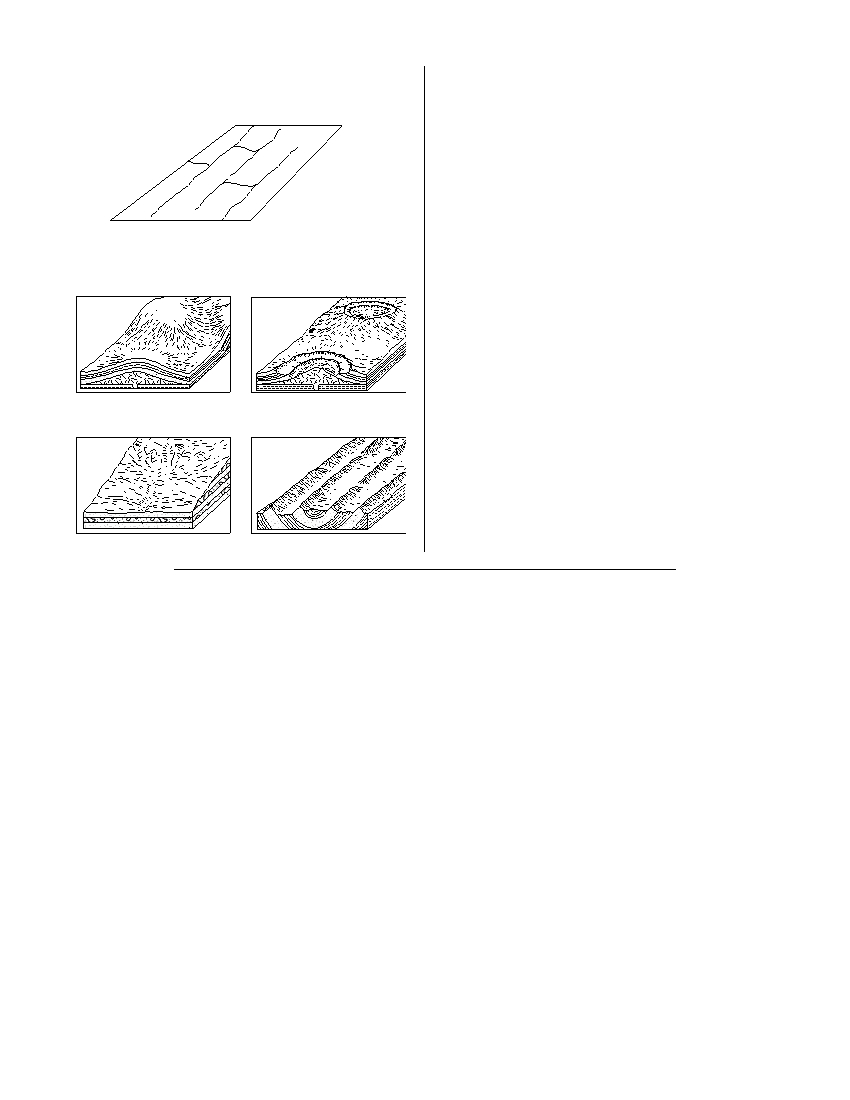
34 The diagram below represents a map view of a
35 Compared to a maritime tropical air mass, a
stream drainage pattern.
maritime polar air mass has a
(1) higher temperature and more water vapor
(2) higher temperature and less water vapor
(3) lower temperature and more water vapor
(4) lower temperature and less water vapor
Which underlying bedrock structure most likely
produced this stream drainage pattern?
( 1 )
( 3 )
( 2 )
( 4 )
P.S./E. Sci.–June ’05
[7]
[OVER]
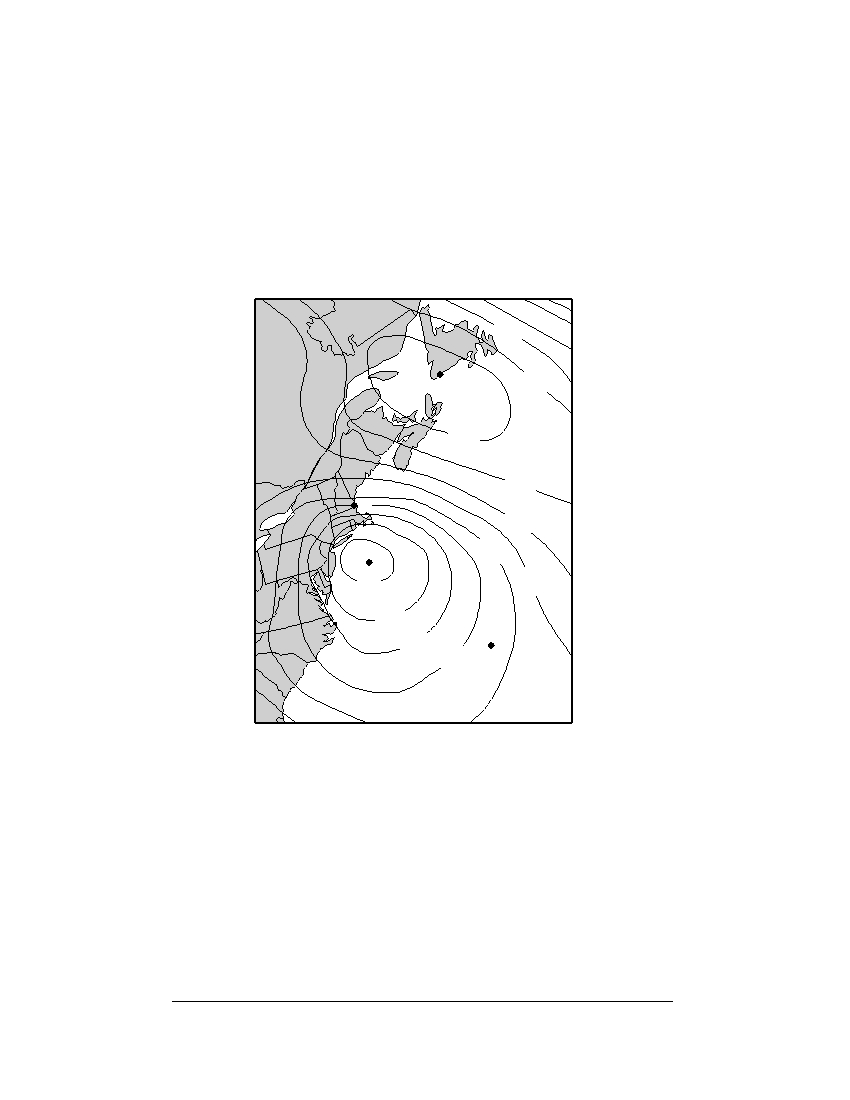
Part B–1
Answer all questions in this part.
Directions (36–50): For each statement or question, write on your separate answer sheet the number of the
word or expression that, of those given, best completes the statement or answers the question. Some questions
may require the use of the Earth Science Reference Tables .
Base your answers to questions 36 through 38 on the map below, which shows sea-level air pressure, in
millibars, for a portion of the eastern coast of North America. Points A, B, C, and D are sea-level locations on
Earth’s surface.
Sea-Level Air Pressures
1020
A
1024
North
1028
America
Atlantic
Ocean
1024
B
1020
1012
C
1016
996
1000
1004
D
1008
36 Which weather instrument was used to measure the air pressures?
(1) thermometer
(3) sling psychrometer
(2) wind vane
(4) barometer
37 Which location most likely recorded the highest wind speed?
(1) A
(3) C
(2) B
(4) D
38 The air pressure recorded at point D was most likely
(1) 1014 mb
(3) 1010 mb
(2) 1012 mb
(4) 1006 mb
P.S./E. Sci.–June ’05
[8]

Base your answers to questions 39 through 41 on the newspaper article shown below and on your
knowledge of Earth science.
Fossilized Jellyfish Found in Wisconsin
Fossil hunters have unearthed the largest collection of fossilized jellyfish ever
discovered, including the largest fossilized jellyfish ever found.
The remains of soft-bodied animals such as jellyfish are relatively rare because they
don’t have bones, fossil dealer Dan Damrow, James W. Hagadorn of the California Institute
of Technology and Robert H. Dott Jr. of the University of Wisconsin at Madison noted in
describing the find in the journal Geology.
About a half-billion years ago, during the Cambrian period, the quarry in Mosinee,
Wis., where the deposits were found was a small lagoon. The jellyfish apparently died when
they were washed up by a freak tide or storm, the researchers said. The jellyfish remains
were probably preserved because of a lack of erosion from sea water and wind, and a lack
of scavengers, the researchers concluded.
“It is very rare to discover a deposit which contains an entire stranding event of jelly-
fish,” Hagadorn said. “These jellyfish are not just large for the Cambrian, but are the largest
jellyfish in the entire fossil record.”
Washington Post, January 2002
39 These fossilized jellyfish were most likely discovered in which type of rock?
(1) sandstone
(3) pumice
(2) granite
(4) slate
40 Which two marine organisms most likely lived at the same time as these jellyfish?
(1) crinoids and dinosaurs
(3) brachiopods and gastropods
(2) ammonoids and placoderm fish
(4) amphibians and eurypterids
41 Which evidence would lead scientists to suspect that a tide or storm had washed up
these jellyfish on a beach?
(1) Primitive life existed on land 500 million years ago.
(2) The rock containing the jellyfish fossils has distorted crystal structure.
(3) Treeroot fossils appear to have been pitted and folded.
(4) Large ripple marks were found in the fossil-containing rock layers.
P.S./E. Sci.–June ’05
[9]
[OVER]
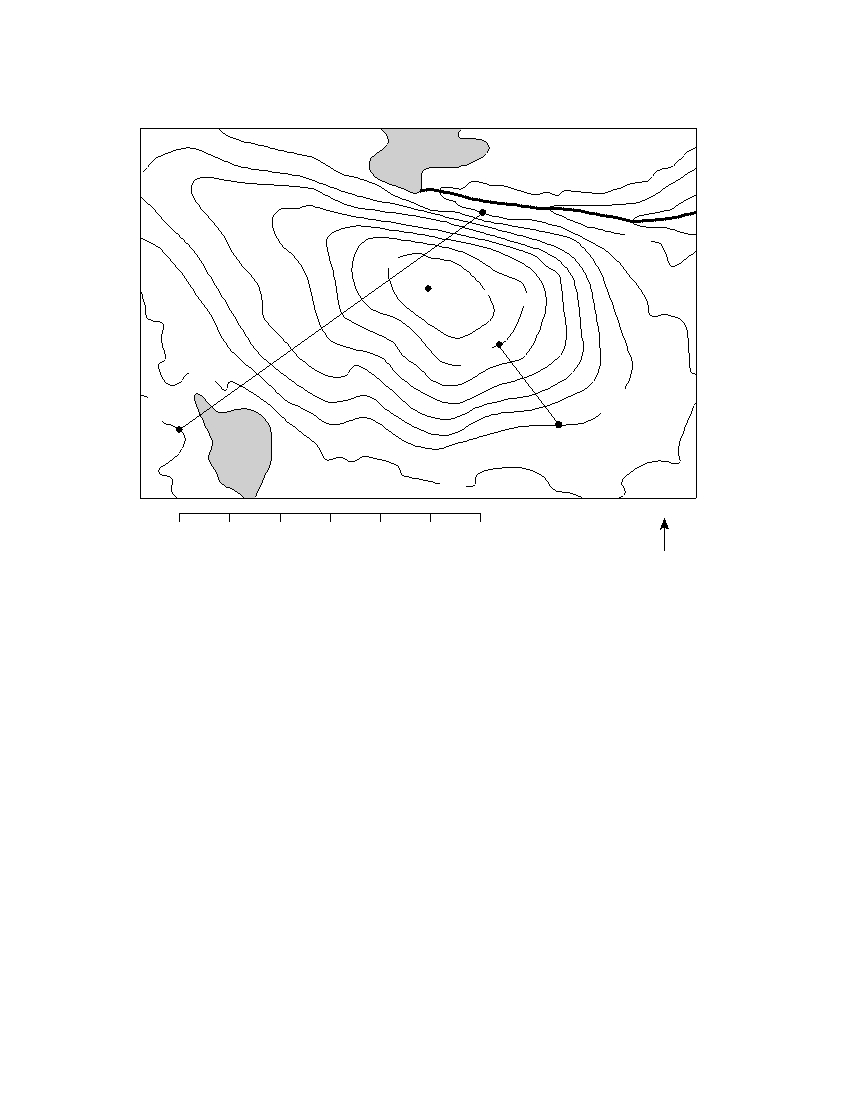
Base your answers to questions 42 through 44 on the topographic map below. Points A, B, C, D, and X
represent locations on the map. Elevations are measured in feet.
Lake
F i s h C r e e k
B
800
R
o
c
k
M
o
u
X
n
t
a
i n
C
1500
900
900
1000
A
D
Lake
900
N
0
1
2
3
4
5
6 miles
42 What is the highest possible elevation of point X on Rock Mountain?
(1) 1,599 ft
(3) 1,601 ft
(2) 1,600 ft
(4) 1,699 ft
43 What is the average gradient of the slope along straight line CD ?
(1) 100 ft/mi
(3) 500 ft/mi
(2) 250 ft/mi
(4) 1,000 ft/mi
P.S./E. Sci.–June ’05
[10]
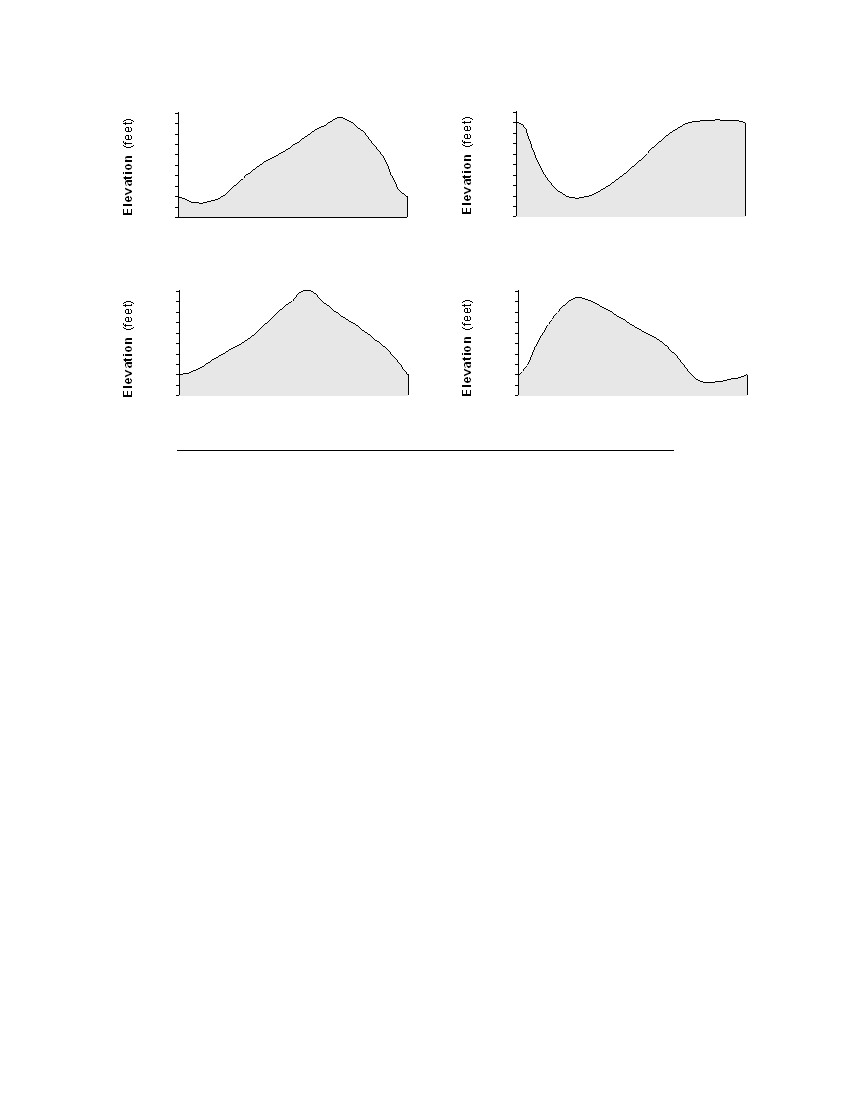
44 Which cross section best represents the profile along straight line AB ?
1700
1700
1500
1500
1300
1300
1100
1100
900
900
700
700
A
B
A
B
( 1 )
( 3 )
1700
1700
1500
1500
1300
1300
1100
1100
900
900
700
700
A
B
A
B
( 2 )
( 4 )
P.S./E. Sci.–June ’05
[11]
[OVER]
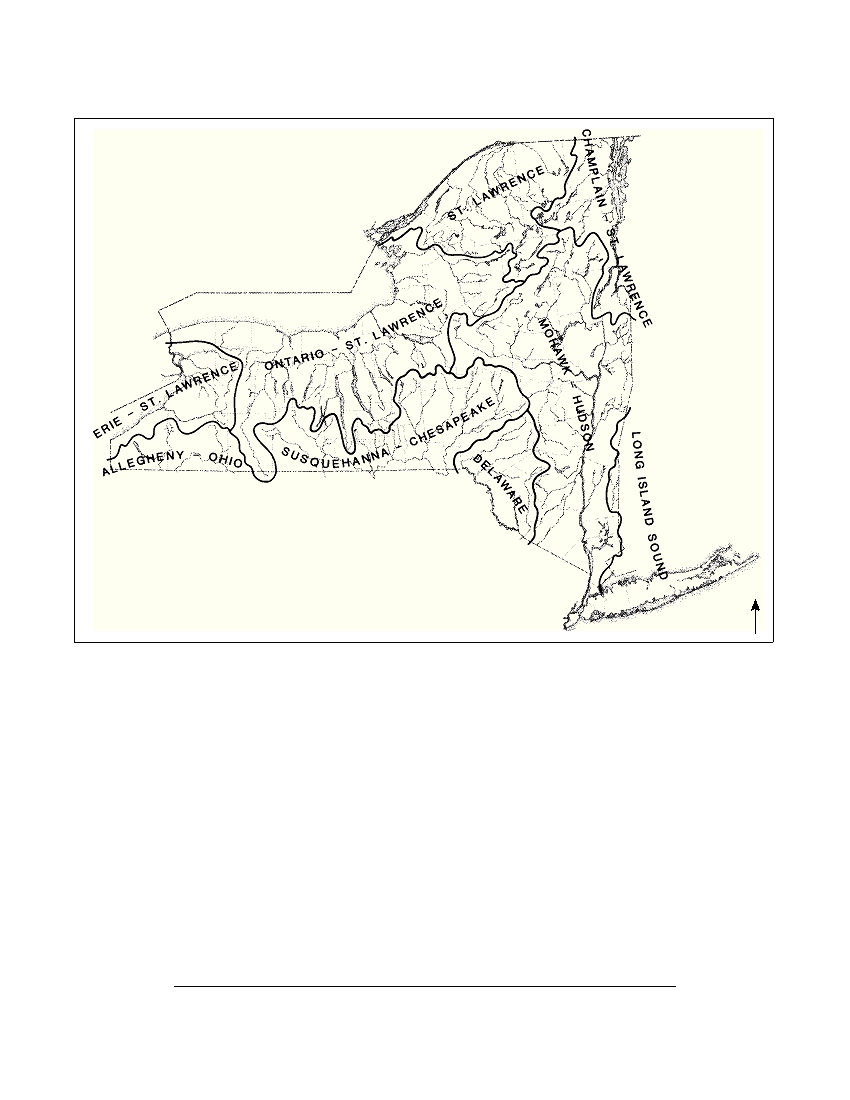
Base your answers to questions 45 through 47 on the map below, which shows watershed regions of
New York State.
N
45 On which type of landscape region are both the Susquehanna-Chesapeake and the
Delaware watersheds located?
(1) plain
(3) mountain
(2) plateau
(4) lowland
46 In which watershed is the Genesee River located?
(1) Ontario-St. Lawrence
(3) Mohawk-Hudson
(2) Susquehanna-Chesapeake
(4) Delaware
47 Most of the surface bedrock of the Ontario-St. Lawrence watershed was formed
during which geologic time periods?
(1) Precambrian and Cambrian
(2) Ordovician, Silurian, and Devonian
(3) Mississippian, Pennsylvanian, and Permian
(4) Triassic, Jurassic, and Cretaceous
P.S./E. Sci.–June ’05
[12]
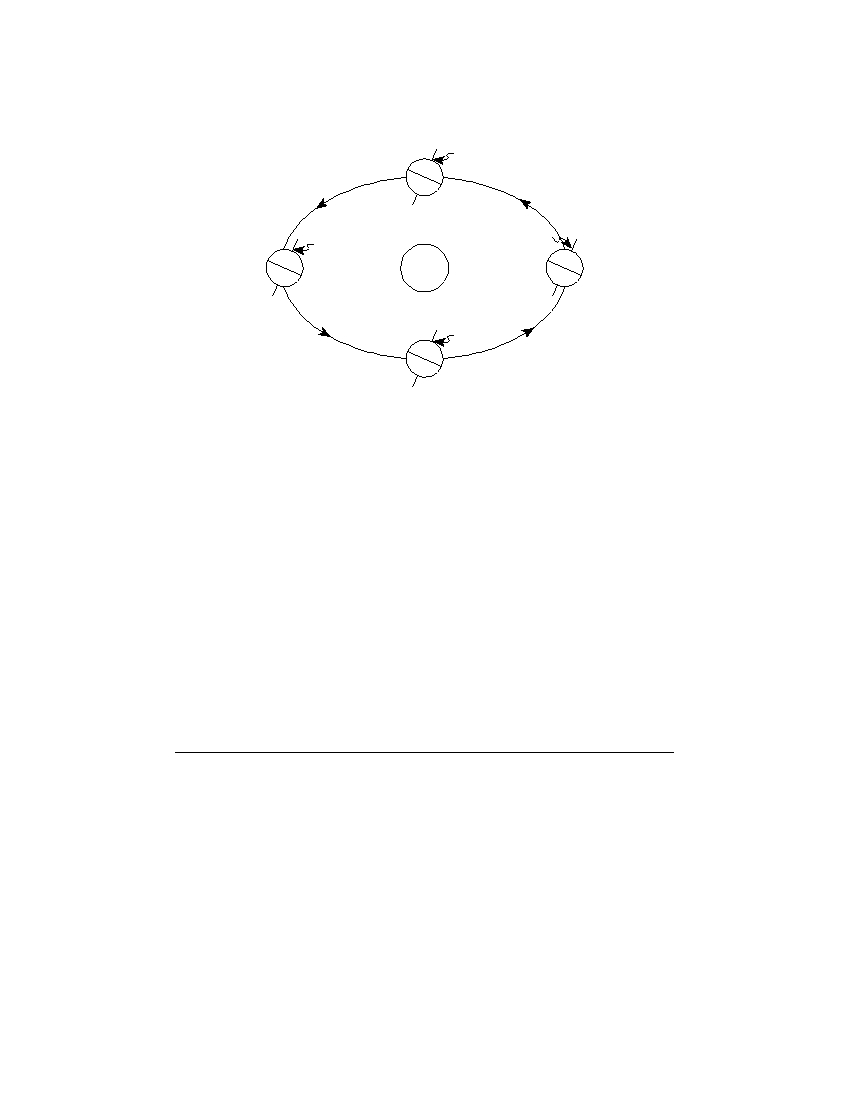
Base your answers to questions 48 through 50 on the diagram below, which represents an exaggerated view
of Earth revolving around the Sun. Letters A, B, C, and D represent Earth’s location in its orbit on the first day
of each of the four seasons.
A
North
Pole
North
D
B
North
Pole
Pole
Sun
North
Pole
C
(Not drawn to scale)
48 Which location in Earth’s orbit represents the first day of fall (autumn) for an
observer in New York State?
(1) A
(3) C
(2) B
(4) D
49 Earth’s rate of revolution around the Sun is approximately
(1) 1° per day
(3) 15° per hour
(2) 360° per day
(4) 23.5° per hour
50 Which observation provides the best evidence that Earth revolves around the Sun?
(1) Stars seen from Earth appear to circle Polaris .
(2) Earth’s planetary winds are deflected by the Coriolis effect.
(3) The change from high ocean tide to low ocean tide is a repeating pattern.
(4) Different star constellations are seen from Earth at different times of the year.
P.S./E. Sci.–June ’05
[13]
[OVER]
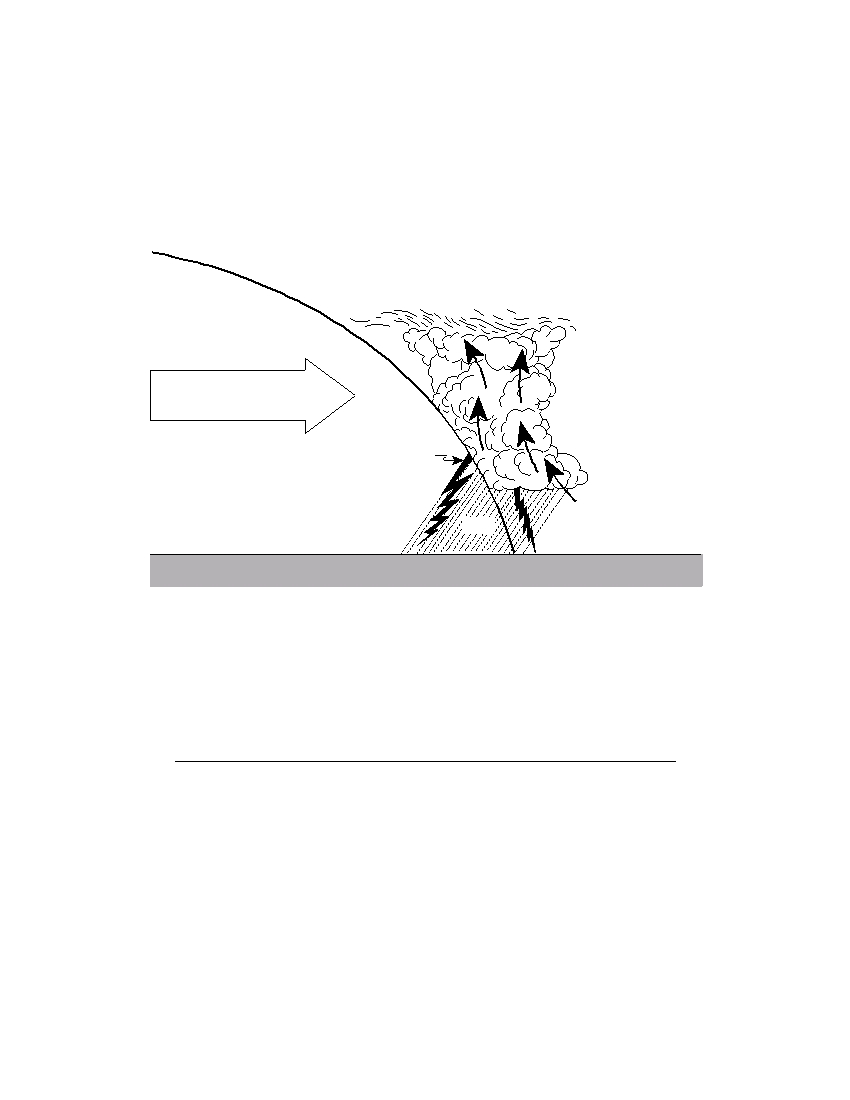
Part B–2
Answer all questions in this part.
Directions (51–65): Record your answers in the spaces provided in your answer booklet. Some questions
may require the use of the Earth Science Reference Tables.
Base your answers to questions 51 through 53 on the cross section below, which shows a typical cold front
moving over New York State in early summer.
Direction of
movement
Cumulonimbus clouds
Lightning
cP
mT
Cold, dry air
Rain
Warm, moist air
Cold front
51 Explain why the warm, moist air is rising at the frontal boundary. [ 1 ]
52 State one process that causes clouds to form in this rising air. [ 1 ]
53 Central Canada was the geographic source region for the cP air mass shown in the
cross section. Identify the most likely geographic source region for the mT air mass
shown in the cross section. [ 1 ]
P.S./E. Sci.–June ’05
[14]
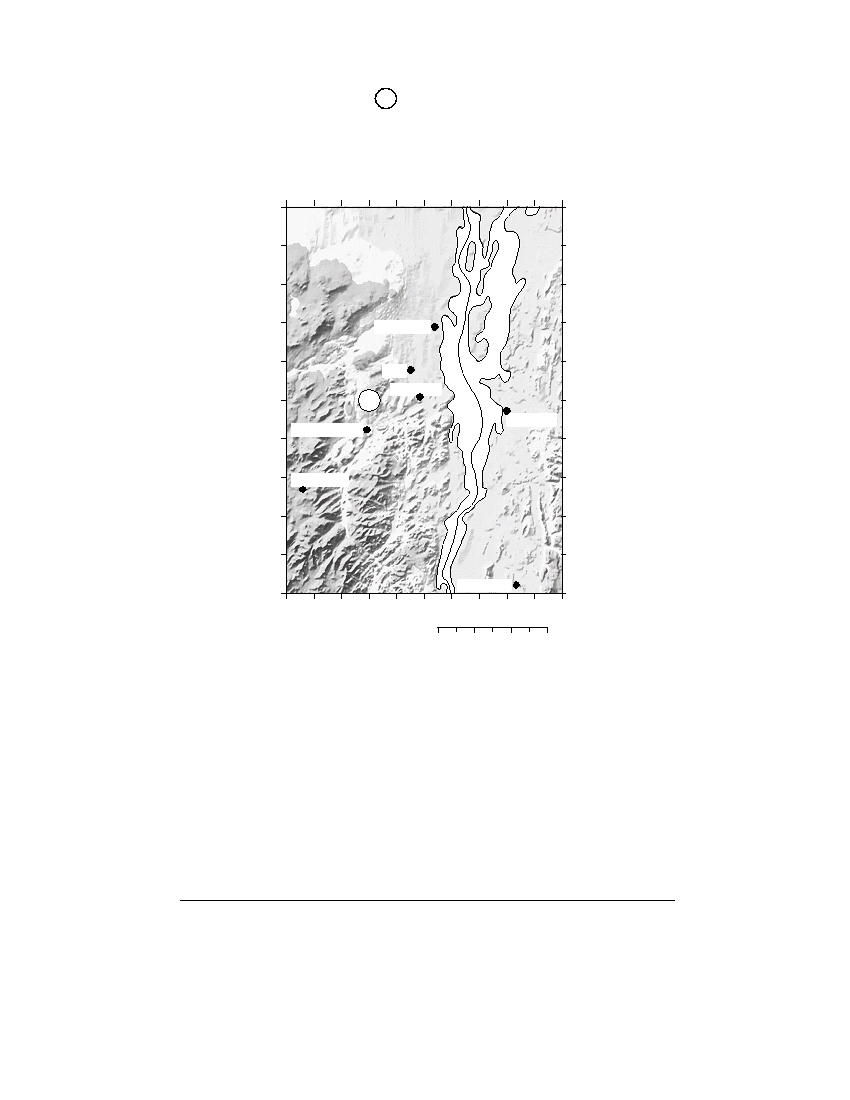
Base your answers to questions 54 through 57 on the map below and on your knowledge of Earth science.
The map shows the location of the epicenter, X , of an earthquake that occurred on April 20, 2002, about
29 kilometers southwest of Plattsburgh, New York.
Plattsburgh, New York
Earthquake on April 20, 2002
45 ° N
New York
44.8 ° N
Plattsburgh
Lake
44.6 ° N
Peru
Champlain
Keeseville
X
Burlington
Ausable Forks
44.4 ° N
Lake Placid
44.2 ° N
Vermont
Middlebury
44 ° N
74 ° W
73.8 ° W
73.6 ° W
73.4 ° W
73.2 ° W
73 ° W
0
10
20
30 km
54 State the latitude and longitude of this earthquake epicenter. Express your answers
to the nearest tenth of a degree and include the compass directions. [ 1 ]
55 What is the minimum number of seismographic stations needed to locate the epi-
center of an earthquake? [ 1 ]
56 Explain why this earthquake was most likely felt with greater intensity by people in
Peru, New York, than by people in Lake Placid, New York. [ 1 ]
57 A seismic station located 1,800 kilometers from the epicenter recorded the P -wave
and S -wave arrival times for this earthquake. What was the difference in the arrival
time of the first P -wave and the first S -wave? [ 1 ]
P.S./E. Sci.–June ’05
[15]
[OVER]
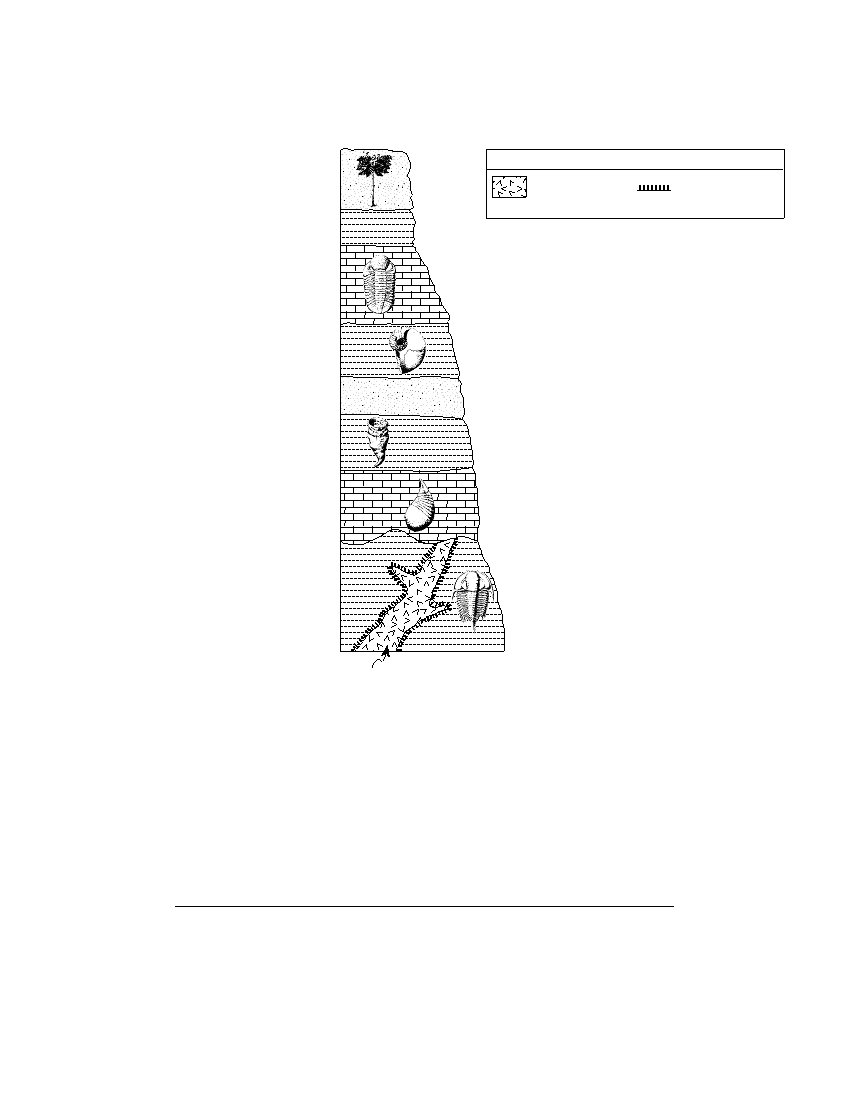
Base your answers to questions 58 through 60 on the cross section of the bedrock outcrop shown below and
on your knowledge of Earth science. Index fossils found in some of the rock units are shown. The rock units are
labeled I through IX.
Key
I
Igneous rock
Contact
metamorphism
II
III
IV
V
VI
VII
VIII
IX
58 In the space provided in your answer booklet, number the relative age of rock units
VII, VIII, and IX from 1 to 3, with number 1 indicating the oldest rock and number 3
indicating the youngest rock. [ 1 ]
59 The fossil shown in rock unit VIII is a member of an extinct group of fossils. State
two other index fossils that are also members of the same group of extinct fossils. [ 1 ]
60 Based on the fossils shown in the limestone and shale layers, state the type of
environment in which these sedimentary rocks were deposited. [ 1 ]
P.S./E. Sci.–June ’05
[16]
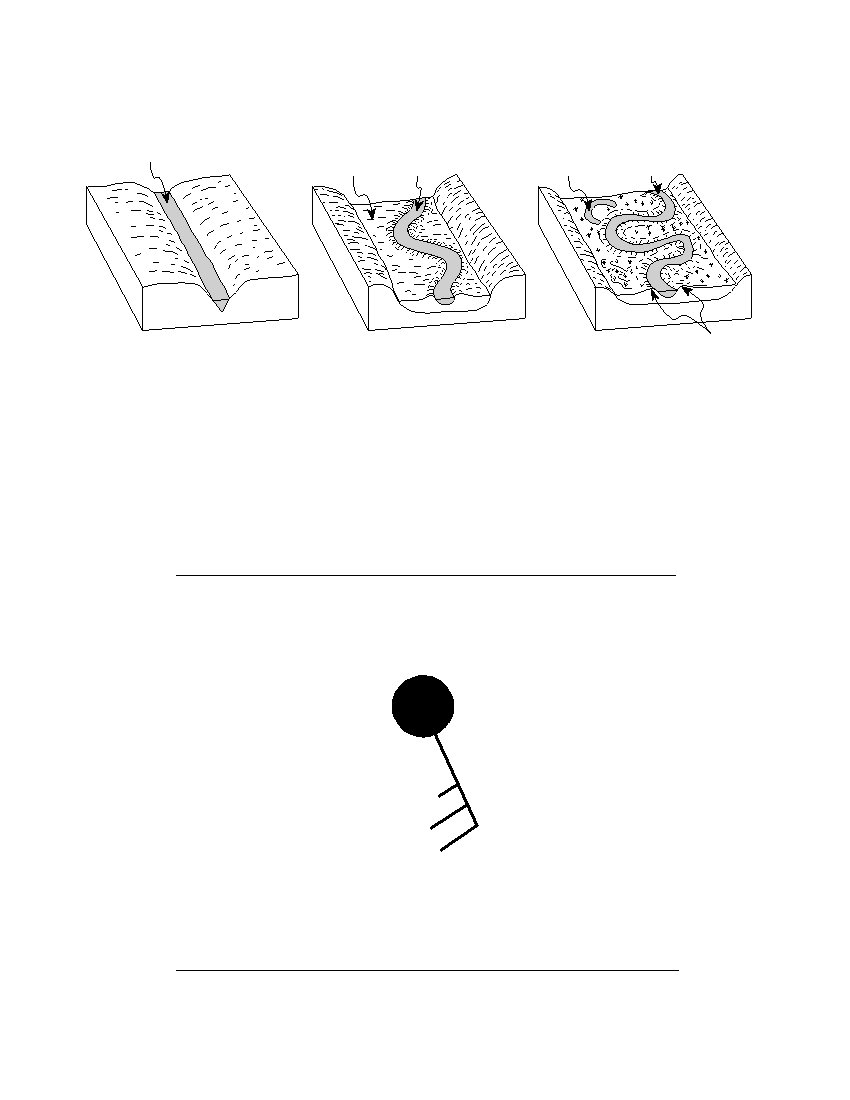
Base your answers to questions 61 through 63 on the block diagrams below, which show three types of
streams with equal volumes.
Type 1
Type 2
Type 3
Straight channel
Flood
Winding
Oxbow
Meandering
plain
channel
lake
channel
Levees
Narrow, V-shaped
Wider valley with
Broad valley with wide,
valley
sloping walls
swampy flood plain
61 Explain how the differences between the type 1 and type 3 stream channels indicate
that the average velocities of the streams are different. [ 1 ]
62 Explain why the outside of the curve of a meandering channel experiences more
erosion than the inside of the curve. [ 1 ]
63 Explain how the cobbles and pebbles that were transported by these streams
became smooth and rounded in shape. [ 1 ]
Base your answers to questions 64 and 65 on the station model below, which shows the weather conditions
at Rochester, New York, at 4 p.m. on a particular day in June.
83
021
–25\
82
.50
64 What was the actual barometric pressure, according to the station model, to the
nearest tenth of a millibar ? [ 1 ]
65 The winds shown by this station model were blowing from which compass direction
and at what wind speed? [ 1 ]
P.S./E. Sci.–June ’05
[17]
[OVER]
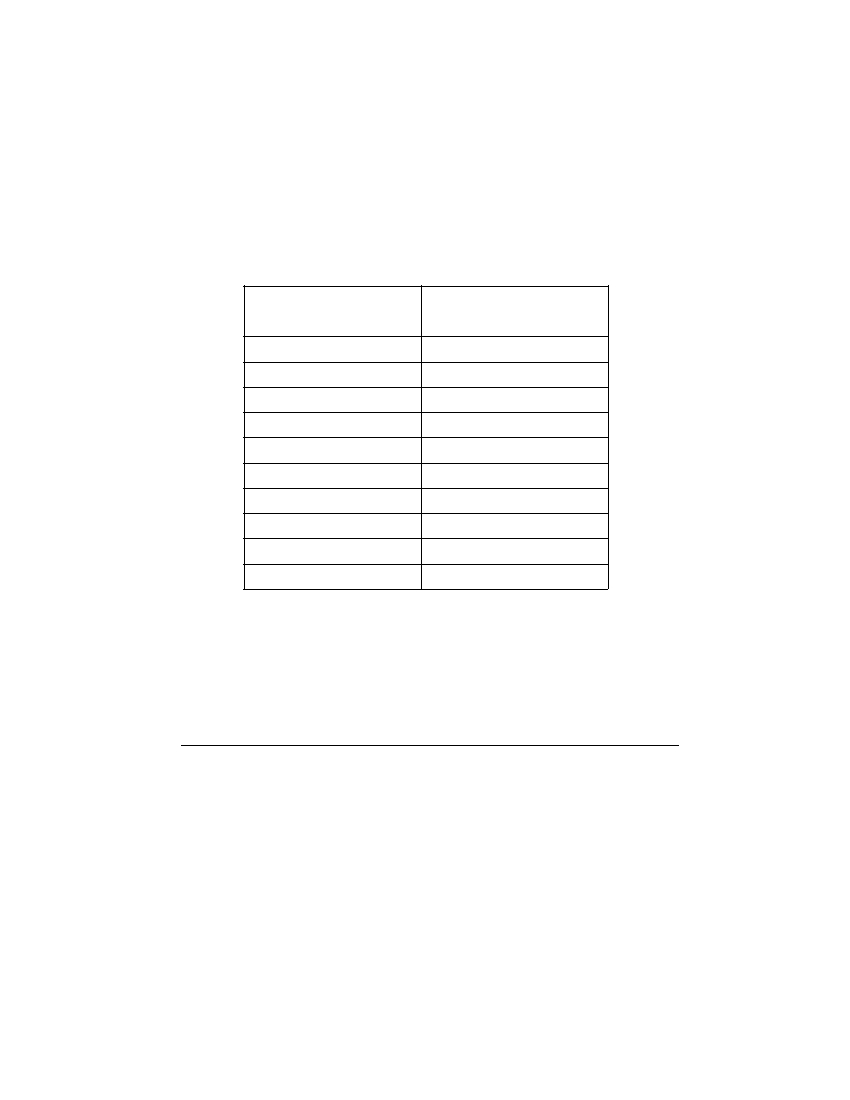
Part C
Answer all questions in this part.
Directions (66–83): Record your answers in the spaces provided in your answer booklet. Some questions
may require the use of the Earth Science Reference Tables.
Base your answers to questions 66 and 67 on the data table below, which lists the apparent diameter of the
Sun, measured in minutes and seconds of a degree, as it appears to an observer in New York State. (Apparent
diameter is how large an object appears to an observer.)
Apparent Diameter of the Sun During the Year
Apparent Diameter
Date
( ' = minutes '' = seconds)
January 1
32'32''
February 10
32'25''
March 20
32'07''
April 20
31'50''
May 30
31'33''
June 30
31'28''
August 10
31'34''
September 20
31'51''
November 10
32'18''
December 30
32'32''
66 On the grid provided in your answer booklet, graph the data shown on the table by
marking with a dot the apparent diameter of the Sun for each date listed and con-
necting the dots with a smooth, curved line. [ 2 ]
67 Explain why the apparent diameter of the Sun changes throughout the year as Earth
revolves around the Sun. [ 1 ]
P.S./E. Sci.–June ’05
[18]

Base your answers to questions 68 through 71 on the passage below and on your knowledge of Earth
science.
Watching the Glaciers Go
Mountain glaciers and ice caps in tropical areas of the world are melting fast and may
vanish altogether by the year 2020. That was the chilling news last year from Lonnie
Thompson, a geologist at Ohio State University’s Byrd Polar Research Center who has been
studying icy areas near the equator in South America, Africa, and the Himalayas for two
decades.
It doesn’t take a glacier scientist to see the changes. In 1977, when Thompson visited the
Quelccaya ice cap in Peru, it was impossible not to notice a schoolbus-size boulder stuck in
its grip. When Thompson returned in 2000, the rock was still there but the ice wasn’t — it
had retreated far into the distance.
Most scientists believe the glaciers are melting because of global warming — the
gradual temperature increase that has been observed with increasing urgency during the
past decade. Last year a panel of the nation’s top scientists, the National Research Council,
set aside any lingering skepticism about the phenomenon, concluding definitively that
average global surface temperatures are rising and will continue to do so.
“Watching the Glaciers Go,”
Popular Science, vol. #7, January 2002
68 State one greenhouse gas that is an excellent absorber of infrared radiation and may
be responsible for global warming. [ 1 ]
69 Describe the arrangement of sediment deposited directly from glaciers. [ 1 ]
70 Some glaciers currently exist near Earth’s equator due to the cold, snowy climate of
certain locations. Which type of landform exists where these glaciers occur? [ 1 ]
71 Describe one action humans could take to reduce the global warming that is
melting the Quelccaya ice cap. [ 1 ]
P.S./E. Sci.–June ’05
[19]
[OVER]
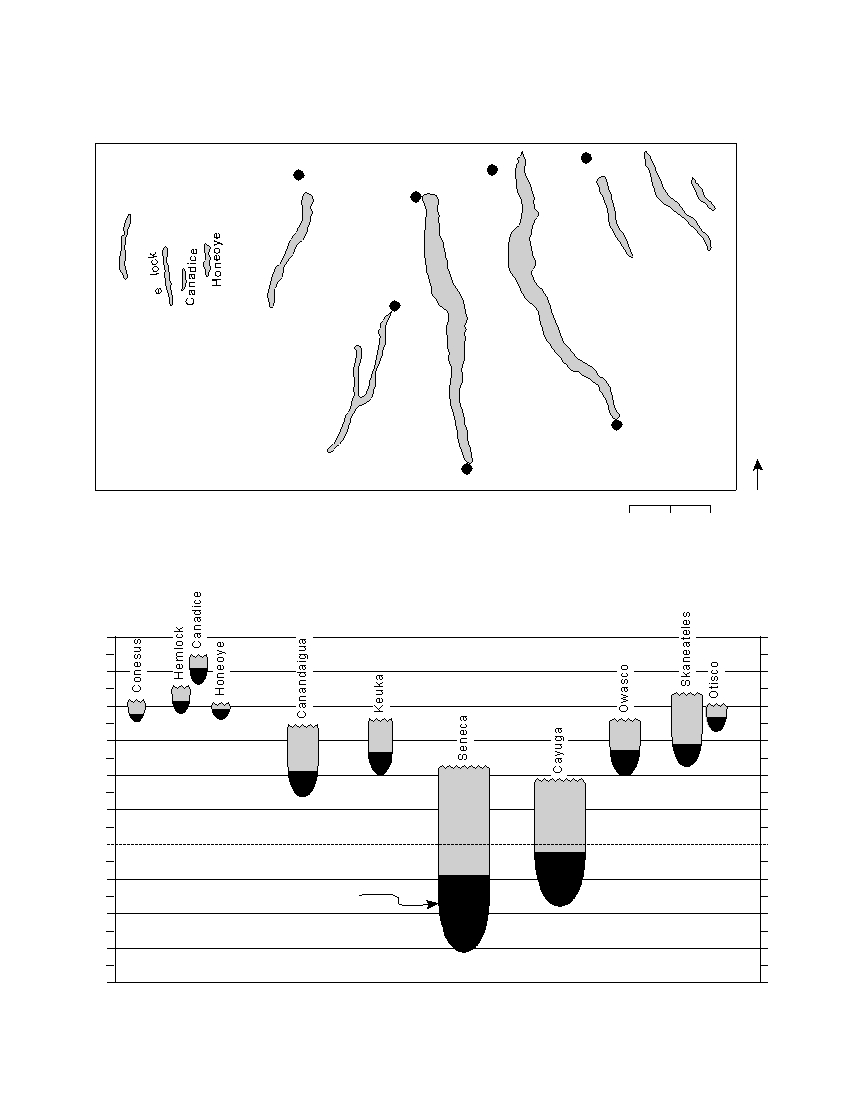
Base your answers to questions 72 through 75 on the map and cross section of the Finger Lakes Region
shown below and on your knowledge of Earth science.
Finger Lakes Region of New York State
Auburn
Otisco
Canandaigua
Waterloo
Skaneateles
Geneva
Seneca
Owasco
Conesus
m
H
Canandaigua
Cayuga
Penn Yan
Keuka
Ithaca
N
Watkins Glen
0
5
10 mi
Elevation and Depth of the Finger Lakes
of New York State (measured in feet)
1000
500
Sea level
0
Sediment fill
–500
P.S./E. Sci.–June ’05
[20]

72 According to the cross section, how thick from top to bottom is the sediment fill in
Seneca Lake? [ 1 ]
73 State one possible explanation for the north-south orientation of the Finger Lakes.
[ 1 ]
74 During some winters, a few of the Finger Lakes remain unfrozen even though the
land around the lakes is frozen. Explain how the specific heat of water can cause these
lakes to remain unfrozen. [ 1 ]
75 Identify two processes that normally occur to form the type of surface bedrock
found in the Finger Lakes Region. [ 1 ]
Base your answers to questions 76 through 79 on the diagram provided in your answer booklet, which shows
observations made by a sailor who left his ship and landed on a small deserted island on June 21. The diagram
represents the apparent path of the Sun and the position of Polaris, as observed by the sailor on this island.
76 On the diagram provided in your answer booklet, draw an arrow on the June 21 path of
the Sun to show the Sun’s direction of apparent movement from sunrise to sunset. [ 1 ]
77 The sailor was still on the island on September 23. On the diagram provided in your
answer booklet, draw the Sun’s apparent path for September 23, as it would have
appeared to the sailor. Be sure your September 23 path indicates the correct altitude
of the noon Sun and begins and ends at the correct points on the horizon. [ 2 ]
78 Based on the sailor’s observations, what is the latitude of this island? Include the
units and the compass direction in your answer. [ 1 ]
79 The sailor observed a 1-hour difference between solar noon on the island and solar
noon at his last measured longitude onboard his ship. How many degrees of longitude
is the island from the sailor’s last measured longitude onboard his ship? [ 1 ]
P.S./E. Sci.–June ’05
[21]
[OVER]
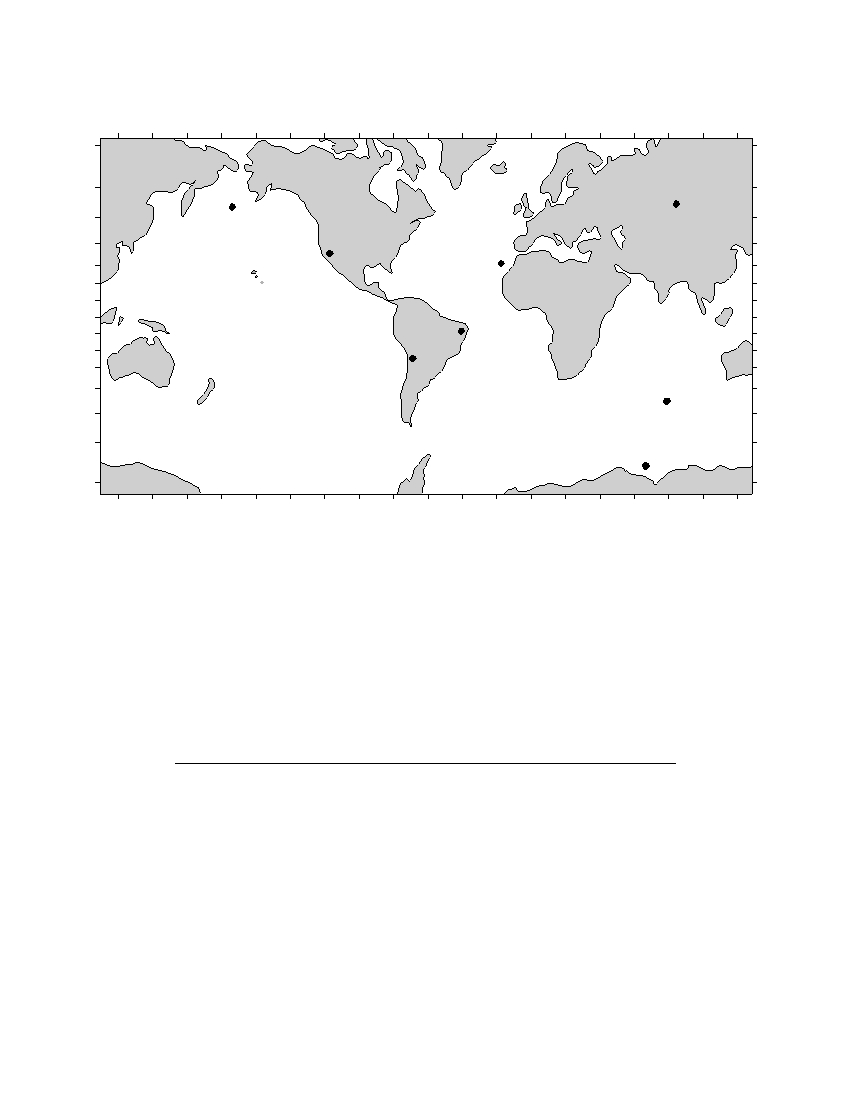
Base your answers to questions 80 through 83 on the world map shown below and on your knowledge of
Earth science. Letters A through H represent locations on Earth’s surface.
120 140 160 180 160 140 120 100
80
60
40
20
0
20
40
60
80
100 120
70
70
Asia
60
60
A
F
Asia
North
Europe
50
America
50
40
Hawaiian
B
E
40
30
Islands
30
20
Atlantic Ocean
20
Africa
10
10
0
Pacific Ocean
South
0
10
America
D
10
20
C
20
30
Australia
Indian Ocean
30
40
40
G
50
50
60
60
H
70
Antarctica
Antarctica
70
120 140 160 180 160 140 120 100
80
60
40
20
0
20
40
60
80
100 120
80 Explain why most earthquakes that occur in the crust beneath location B are
shallower than most earthquakes that occur in the crust beneath location C . [ 1 ]
81 Explain why location A has a greater probability of experiencing a major earthquake
than location D . [ 1 ]
82 Explain why a volcanic eruption is more likely to occur at location E than at location F .
[ 1 ]
83 Explain why the geologic age of the oceanic bedrock increases from location G to
location H . [ 1 ]
P.S./E. Sci.–June ’05
[22]
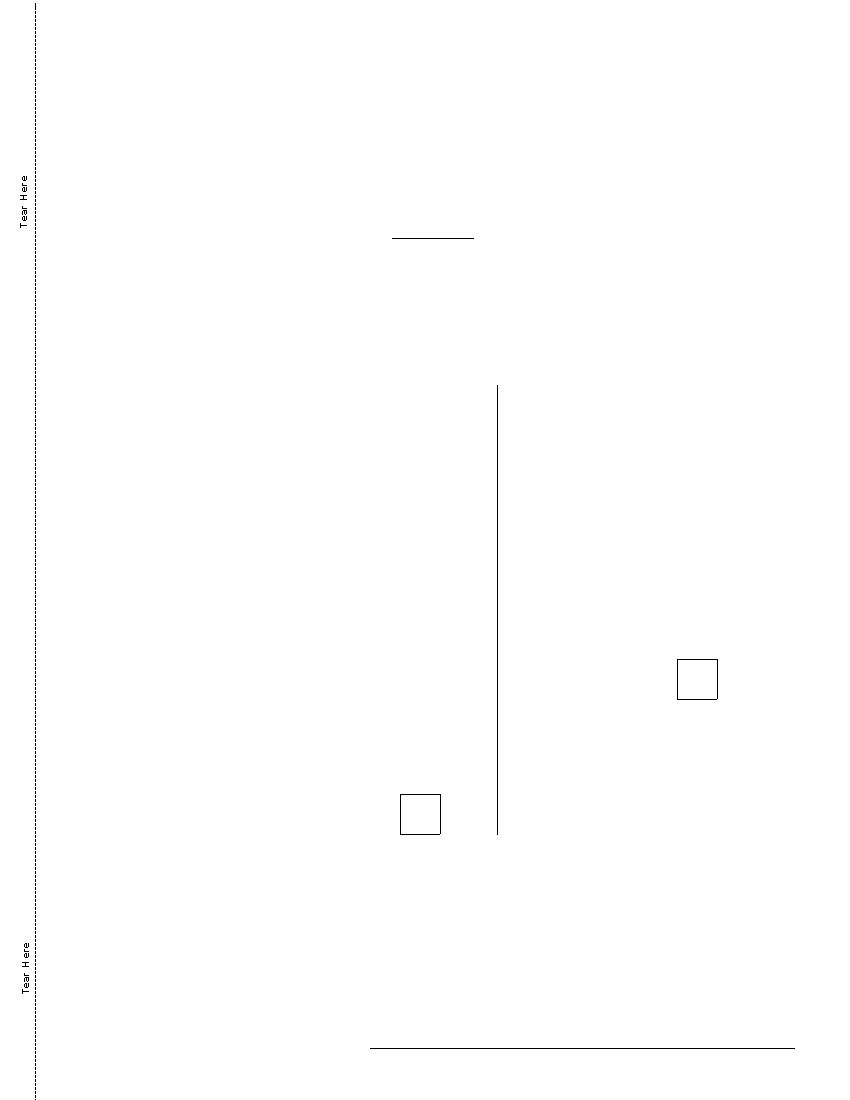
The University of the State of New York
R EGENTS H IGH S CHOOL E XAMINATION
PHYSICAL SETTING
EARTH SCIENCE
Wednesday, June 22, 2005 — 9:15 a.m. to 12:15 p.m., only
ANSWER SHEET
Student . . . . . . . . . . . . . . . . . . . . . . . . . . . . . . . . . . . . . . . . . . . . . . .
Sex:
■ Male ■ Female
Grade . . . . . . . . . . . .
Teacher . . . . . . . . . . . . . . . . . . . . . . . . . . . . . . . . . . . . . . . . . . . . . . .
School . . . . . . . . . . . . . . . . . . . . . . . . . . . . . . . . . . . .
Record your answers to Part A and Part B–1 on this answer sheet.
Part A
Part B–1
1 . . . . . . . . . . . .
13 . . . . . . . . . . . .
25 . . . . . . . . . . .
36 . . . . . . . . . . . .
44 . . . . . . . . . . . .
2 . . . . . . . . . . . .
14 . . . . . . . . . . . .
26 . . . . . . . . . . .
37 . . . . . . . . . . . .
45 . . . . . . . . . . . .
3 . . . . . . . . . . . .
15 . . . . . . . . . . . .
27 . . . . . . . . . . .
38 . . . . . . . . . . . .
46 . . . . . . . . . . . .
4 . . . . . . . . . . . .
16 . . . . . . . . . . . .
28 . . . . . . . . . . .
39 . . . . . . . . . . . .
47 . . . . . . . . . . . .
5 . . . . . . . . . . . .
17 . . . . . . . . . . . .
29 . . . . . . . . . . .
40 . . . . . . . . . . . .
48 . . . . . . . . . . . .
6 . . . . . . . . . . . .
18 . . . . . . . . . . . .
30 . . . . . . . . . . .
41 . . . . . . . . . . . .
49 . . . . . . . . . . . .
7 . . . . . . . . . . . .
19 . . . . . . . . . . . .
31 . . . . . . . . . . .
42 . . . . . . . . . . . .
50 . . . . . . . . . . . .
Part B–1 Score
8 . . . . . . . . . . . .
20 . . . . . . . . . . . .
32 . . . . . . . . . . .
43 . . . . . . . . . . . .
9 . . . . . . . . . . . .
21 . . . . . . . . . . . .
33 . . . . . . . . . . .
10 . . . . . . . . . . . .
22 . . . . . . . . . . . .
34 . . . . . . . . . . .
11 . . . . . . . . . . . .
23 . . . . . . . . . . . .
35 . . . . . . . . . . .
Part A Score
12 . . . . . . . . . . . .
24 . . . . . . . . . . . .
Write your answers to Part B–2 and Part C in your answer booklet.
The declaration below should be signed when you have completed the examination.
I do hereby affirm, at the close of this examination, that I had no unlawful knowledge of the questions or answers prior to
the examination and that I have neither given nor received assistance in answering any of the questions during the examination.
Signature

PS/EARTH SCIENCE
E C N E I C S H T R A E / S P